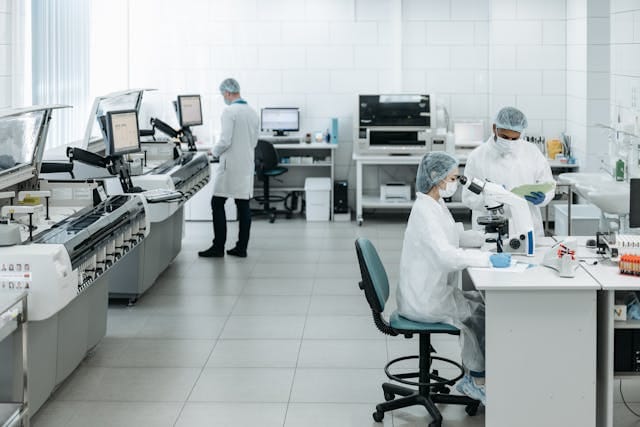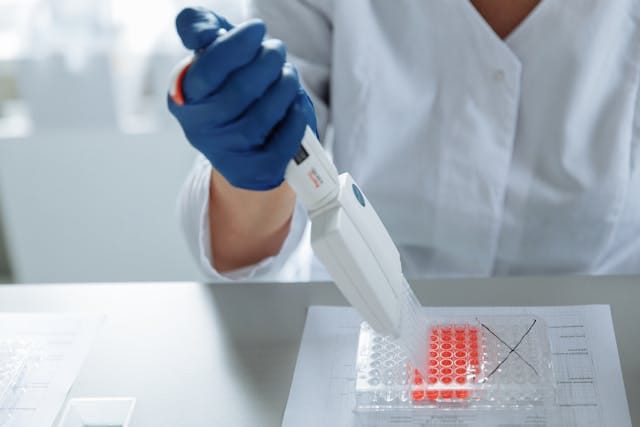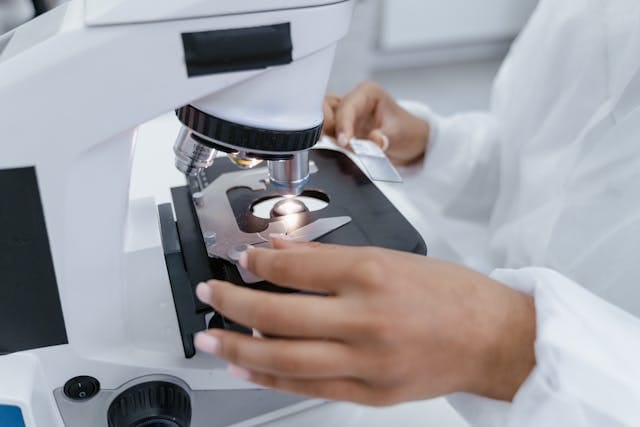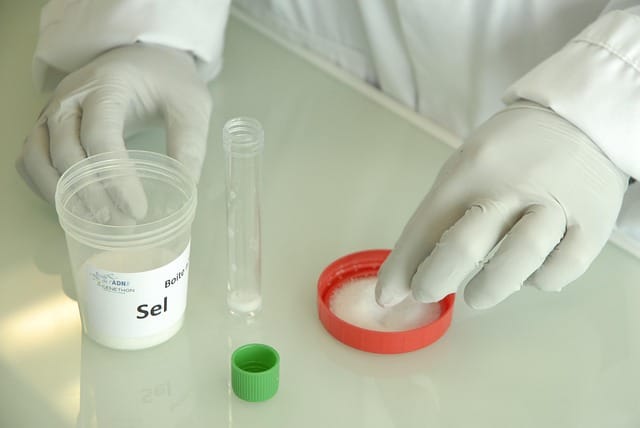DNA Matching definition
DNA matching is the process of using genetic information, specifically DNA profiles, to determine if two DNA samples come from the same individual or have a familial relationship. DNA matching compares a DNA profile from one sample to another (or against a database of profiles) to verify identity or establish a genetic link. This method is a form of biometric identification that can confirm a person’s identity with extreme accuracy by analyzing their genetic code.
What is DNA Matching?
DNA matching refers to the comparison of genetic profiles to see if they originate from the same individual or from biologically related individuals. A DNA profile is a kind of genetic fingerprint, typically a numeric or graphical representation of specific DNA markers unique to an individual. In simpler terms, DNA matching checks whether two DNA fingerprints are a match. Because human DNA is unique to each person (with the rare exception of identical twins), a match provides strong evidence that the samples come from the same person. This process is widely used in biometrics, forensic science, and criminology. Law enforcement and forensic laboratories rely on DNA matching to identify suspects or victims by comparing DNA from crime scene evidence to DNA from a known individual or a database. Beyond criminal identification, DNA matching can also verify biological relationships (for example, confirming parentage) and identify unknown remains by comparing DNA with family members. In all cases, the core principle remains the same: if the genetic markers in two samples match across all tested loci, the samples are deemed to come from the same source or related sources.


How does DNA Matching Work?
DNA matching involves several key steps to go from raw biological sample to a confirmed identity match:
- Sample Collection: First, a sample containing DNA is collected from a person or evidence. This could be a cheek swab, blood, saliva on a cigarette butt, hair root, or other biological material. Even tiny traces can be enough, as nearly every cell in the body contains the same DNA. For example, shed skin cells or drops of blood at a crime scene may yield DNA that investigators can collect.
- DNA Extraction: The collected cells are taken to a lab, where technicians isolate the DNA from other cellular material. This extraction process yields purified DNA from the sample. In forensic labs, even very small amounts of DNA (on the order of nanograms) can be extracted and used for profiling.
- DNA Profiling (Genetic Analysis): Next, the DNA is analyzed to create a profile. Scientists examine specific genetic markers in the DNA that vary greatly between individuals. In modern forensic DNA profiling, this usually means analyzing Short Tandem Repeats (STRs) at standardized loci in the genome. The number of repeats at each locus is measured and recorded as an allele value. By testing a set of these markers (for instance, 13 core STR loci commonly used in criminal justice databases), the lab produces a string of numbers – the DNA profile. This profile is sometimes called a genetic fingerprint because it uniquely identifies the person, yet it does not reveal personal traits. Each profile looks like a unique code. If two samples share the exact code at all loci, they are considered a match. Partial matches could indicate a familial relationship or a degraded sample.
- Comparison and Matching: The DNA profile from the sample is then compared against a reference profile or searched in a DNA database. Specialized software algorithms compare the alleles at each locus between two profiles. If all markers align perfectly (high-stringency match), the software will flag it as a match, meaning the samples likely come from the same individual. In criminal investigations, a profile from a crime scene might be searched in a national database (like the FBI’s CODIS or INTERPOL’s DNA database) to find if it matches any known individual or another crime scene. A “hit” could link a suspect to a crime or even connect multiple crimes to each other through shared DNA evidence. If no immediate match is found, the profile can remain in the database for future comparisons as more profiles are added.
- Verification and Results: When a match is found, scientists perform a quality check to confirm the result. They may calculate a match probability – the statistical likelihood that the match could be coincidental. With the standard STR profiling, this random match probability is extremely low. For example, the chance of two unrelated people having an identical 13-locus DNA profile has been estimated on the order of 1 in hundreds of trillions. In practical terms, a full match gives near-certainty of identification. Once verified, the matching result can be used as evidence to confirm a person’s identity, link a suspect to a crime, or establish a family relationship.


How Important is DNA Matching in Forensic Science and Criminology?
DNA matching has become indispensable in forensic science and modern criminology. Since its first use in the mid-1980s, DNA profiling revolutionized how crimes are solved. It provides an objective scientific method to either convict or exonerate individuals based on biological evidence. For law enforcement, a DNA match can conclusively place a suspect at a crime scene or, conversely, prove someone’s innocence if their DNA does not match the evidence.
In criminal investigations, DNA matching is often considered the gold standard for identification. It allows detectives to solve cases that would be impossible with older methods. For instance, blood, semen, hair, or skin cells left at a crime scene can be analyzed years later to find a perpetrator, even if the person’s identity was unknown at the time of the crime. This has led to the resolution of many cold cases. DNA evidence has also been pivotal in exonerating wrongfully convicted persons, sometimes decades after a trial, by showing that biological evidence from the crime scene does not match the convicted individual.
In criminology, the ability to match DNA profiles aids in understanding patterns of criminal behavior (e.g., linking serial offenses by the same offender through DNA). It also informs the study of recidivism and criminal databases. National DNA databases allow police to cross-check profiles across millions of entries within minutes. This means DNA from a new crime scene can instantly be matched to past crime scenes or offenders, even across different regions, revealing connections (person-to-scene, scene-to-scene, or person-to-person) that investigators would otherwise miss. Such capabilities have dramatically increased the efficiency of solving violent crimes like rape and homicide by identifying repeat offenders.


How Accurate is DNA Matching?
DNA matching is one of the most accurate identification methods available. Because each person’s DNA code is extraordinarily unique, the probability of a false match is extremely low when a sufficient number of genetic markers are compared.
Several factors ensure this high accuracy:
- High Genetic Variability: The regions of DNA used for profiling are chosen specifically because they vary greatly among individuals. By combining multiple independent markers, the combined profile becomes virtually unique. For example, the FBI’s 13-core-loci STR profile has such high discriminating power that random matches are almost statistically impossible.
- Stringent Matching Criteria: For a DNA match in forensics, typically all markers must match exactly. If even one locus differs, the profiles are considered a non-match (except in deliberate familial searches). This exacting standard means that partial similarities do not mistakenly count as positive identifications.
- Quality Control and Statistics: DNA labs incorporate quality checks by re-testing and using control samples. When a match is declared, analysts often calculate a match probability or random match frequency based on population genetics data. For instance, a report may state that the chance of a coincidental match is less than 1 in a trillion for the given profile, reinforcing confidence in the result. Such statistics help judges and juries understand the weight of DNA evidence.
It is important to note that the extremely high accuracy of DNA matching assumes proper procedures are followed. Errors can occur if samples are contaminated or mixed up, but stringent laboratory protocols and independent verifications are in place to minimize human error. Unlike biometric modalities such as face or fingerprint recognition which might have false match rates of a few percent, DNA matching has a nearly zero false positive rate when a full profile is obtained. This makes it the cornerstone of reliable forensic identification.
What are the Limitations of DNA Matching?
Despite its power, DNA matching does have certain limitations and challenges:
- Time and Resources: Traditional DNA analysis is not instantaneous. Collecting and processing DNA evidence can take hours or days in a laboratory. It requires specialized equipment and trained personnel. This means DNA matching is not as immediate as other biometrics like fingerprint or face recognition for on-the-spot identification. However, new Rapid DNA technologies are improving speed, with some devices able to produce a DNA profile in about 90 minutes.
- Not Typically Used for Real-Time Access Control: Because of the time and equipment needed, DNA matching is generally reserved for investigations and high-security scenarios. You won’t scan your DNA to unlock a smartphone or enter an office building – those everyday biometric applications use faster methods. DNA matching might be used for access control only in very secure facilities or situations where absolute certainty of identity is required and time is less critical.
- Privacy and Ethical Concerns: DNA contains intimate genetic information. Storing someone’s DNA profile raises privacy issues and ethical questions. Even though forensic DNA profiles are created from non-coding regions (which don’t reveal traits or diseases), there is public concern about how DNA data is used and who can access it. There are strict laws in many countries about DNA database usage – for example, whose DNA can be collected and how long it can be kept. Misuse of DNA data (for surveillance or unauthorized genealogy searches) is a sensitive issue, so safeguards are needed to maintain public trust.
- Identical Twins and Relatives: DNA matching cannot distinguish between identical twins since they have nearly identical DNA sequences. In cases involving twins, investigators must rely on other evidence because DNA alone won’t tell Twin A from Twin B. Also, close relatives share a significant portion of DNA. A child and parent, or siblings, will have partially matching profiles. This means familial relationships can cause partial matches that require careful interpretation. Investigators now even use familial DNA searching to find relatives of an unknown suspect, but this is a specialized process with its own technical and ethical challenges.
- Degraded or Mixed Samples: Not all DNA evidence is pristine. Crime scene samples can be degraded (e.g., old bones or very small traces) or mixed from multiple individuals (like a sample containing DNA of several people). Such scenarios make it harder to get a clear profile. Sometimes only a partial DNA profile can be obtained, which reduces the certainty of a match. Labs have methods to handle these cases (like mitochondrial DNA tests for very old samples, or probabilistic genotyping software for mixtures), but results may not be as clear-cut as a full STR profile from a single person.
- Contamination and Error: While rare, mistakes can happen. If DNA samples become contaminated (one sample picking up traces of another) or if there are laboratory errors, it can lead to incorrect matching results. High-quality labs follow rigorous protocols to prevent this, such as using separate extraction areas and running negative controls. The reputation of DNA evidence’s accuracy means any error could have serious consequences, so standards for forensic DNA labs are extremely high to mitigate this risk.


What are the Real-World Applications of DNA Matching?
DNA matching has a range of applications in biometrics, law enforcement, and forensic investigations:
- Criminal Investigations: The most well-known use is solving crimes. DNA from crime scene evidence (blood, saliva, etc.) is matched to suspects or to profiles in criminal DNA databases. This helps identify perpetrators in cases of murder, sexual assault, burglary, and other crimes with biological evidence. It can also connect different crime scenes to the same offender (for example, linking serial crimes) even if the suspect’s identity was unknown. DNA matching has become a routine part of police work in many countries, and convictions often hinge on DNA evidence.
- Forensic Identification of Victims: DNA is used to identify victims of crimes, accidents, or disasters. In mass casualty events (natural disasters, plane crashes, war zones), conventional identification might be impossible; DNA matching allows authorities to identify human remains by comparing victim DNA to family reference samples. For missing persons cases, investigators can match unidentified remains to a missing person’s DNA profile or to relatives’ DNA (using familial matching).
- Biometric Verification in High-Security Scenarios: While not common for everyday use, DNA matching can be employed for biometric authentication in scenarios that demand the highest level of security. For example, access to an ultra-secure facility or evidence vault might require DNA verification of personnel to ensure identity. Some government or military programs have explored DNA as an authentication factor when fingerprint or iris might be spoofed
- Paternity and Kinship Testing: Outside of crime and security, one of the most common applications of DNA matching is confirming biological relationships. Courts and laboratories use DNA comparisons to establish paternity (father-child relationships) with very high accuracy. Similarly, siblings, grandparents, and other relatives can be confirmed. This has importance in legal scenarios like inheritance disputes, child support cases, or immigration (proving a family relationship).
- Exoneration and Innocence Projects: DNA matching has been a cornerstone in reviewing and overturning wrongful convictions. Various innocence projects around the world use DNA tests on old evidence to demonstrate that someone in prison does not match the DNA from the crime scene, thereby proving their innocence. This application underscores the justice system’s use of DNA as a tool for correcting mistakes.
- Medical and Research Uses: Although not exactly “matching” in the crime-solving sense, DNA comparisons are used in medical research and identification. For instance, verifying the identity of tissue or blood samples in a biobank can involve DNA matching to ensure no mix-up. In organ transplantation, DNA matching (HLA typing) is critical to match donors and recipients, though that is more genetic compatibility than identification.
Each of these applications relies on the core ability to accurately compare DNA profiles. As DNA sequencing and analysis technologies advance, we may see even broader uses. Rapid on-site DNA tests might be used by police at checkpoints or border crossings in the future to verify identities of individuals who lack documents, by comparing their DNA to family members or to database records. In all cases, DNA matching provides a scientific foundation for identifying people that is highly trusted when used correctly, making it an invaluable tool across biometrics, criminology, and forensic science.